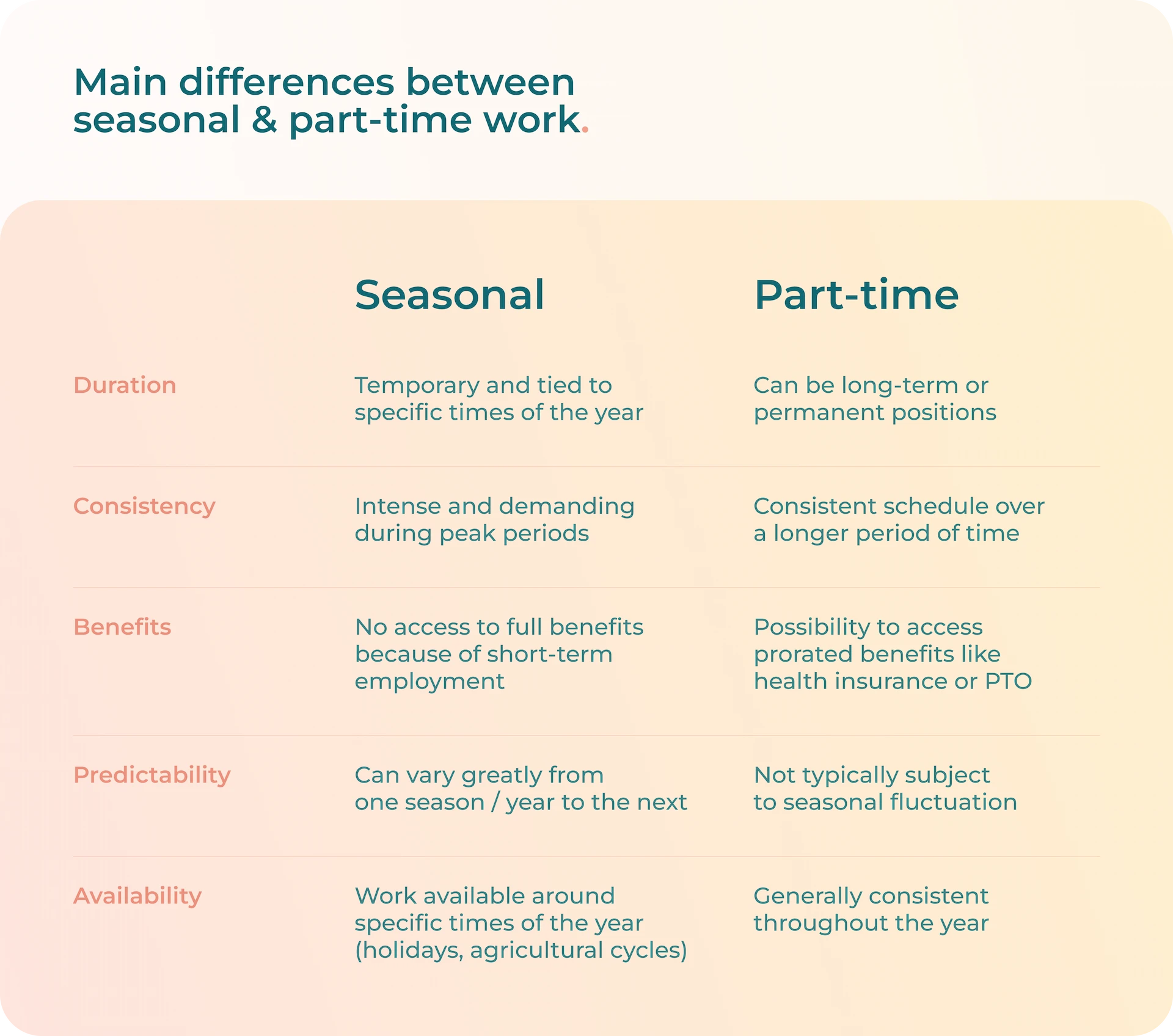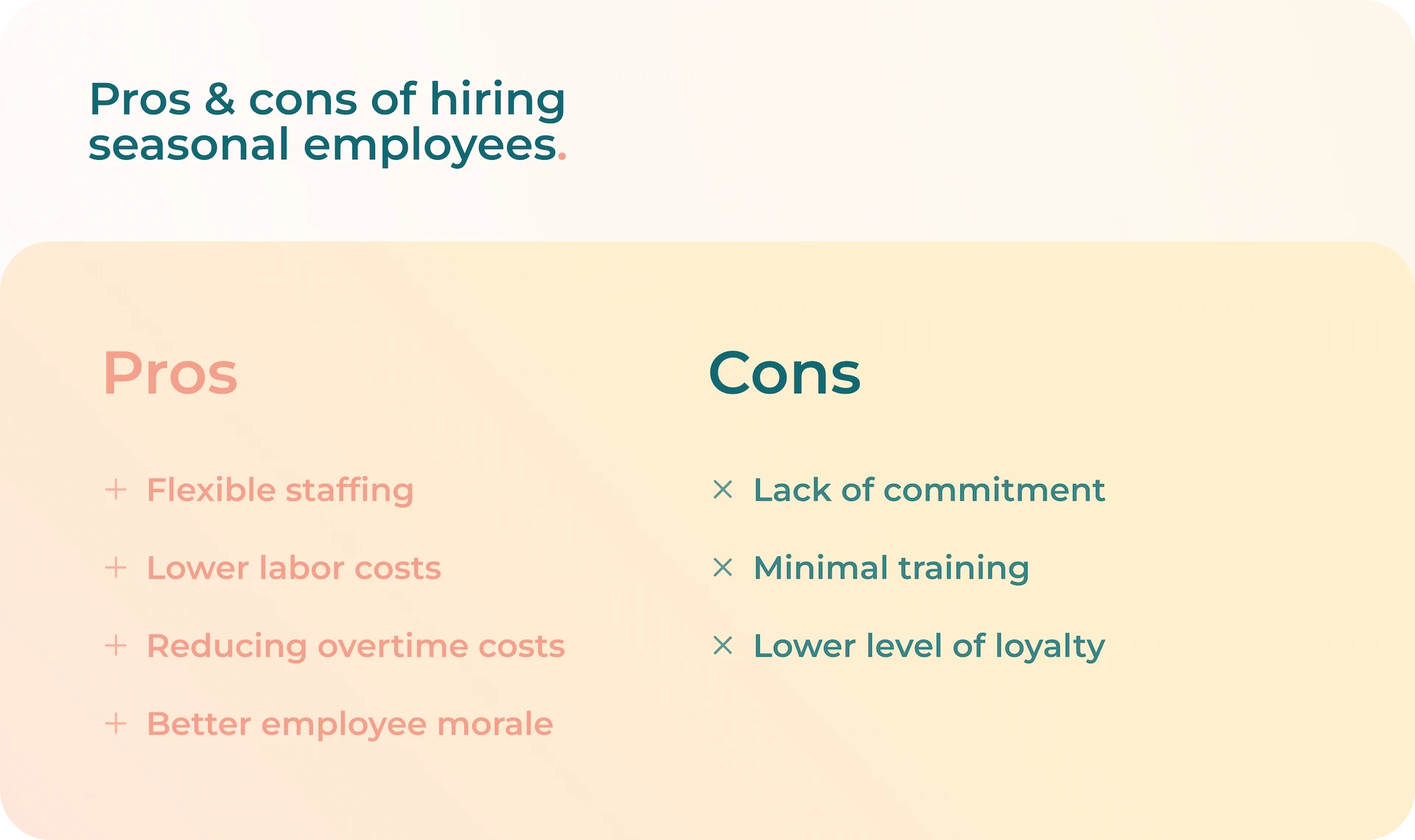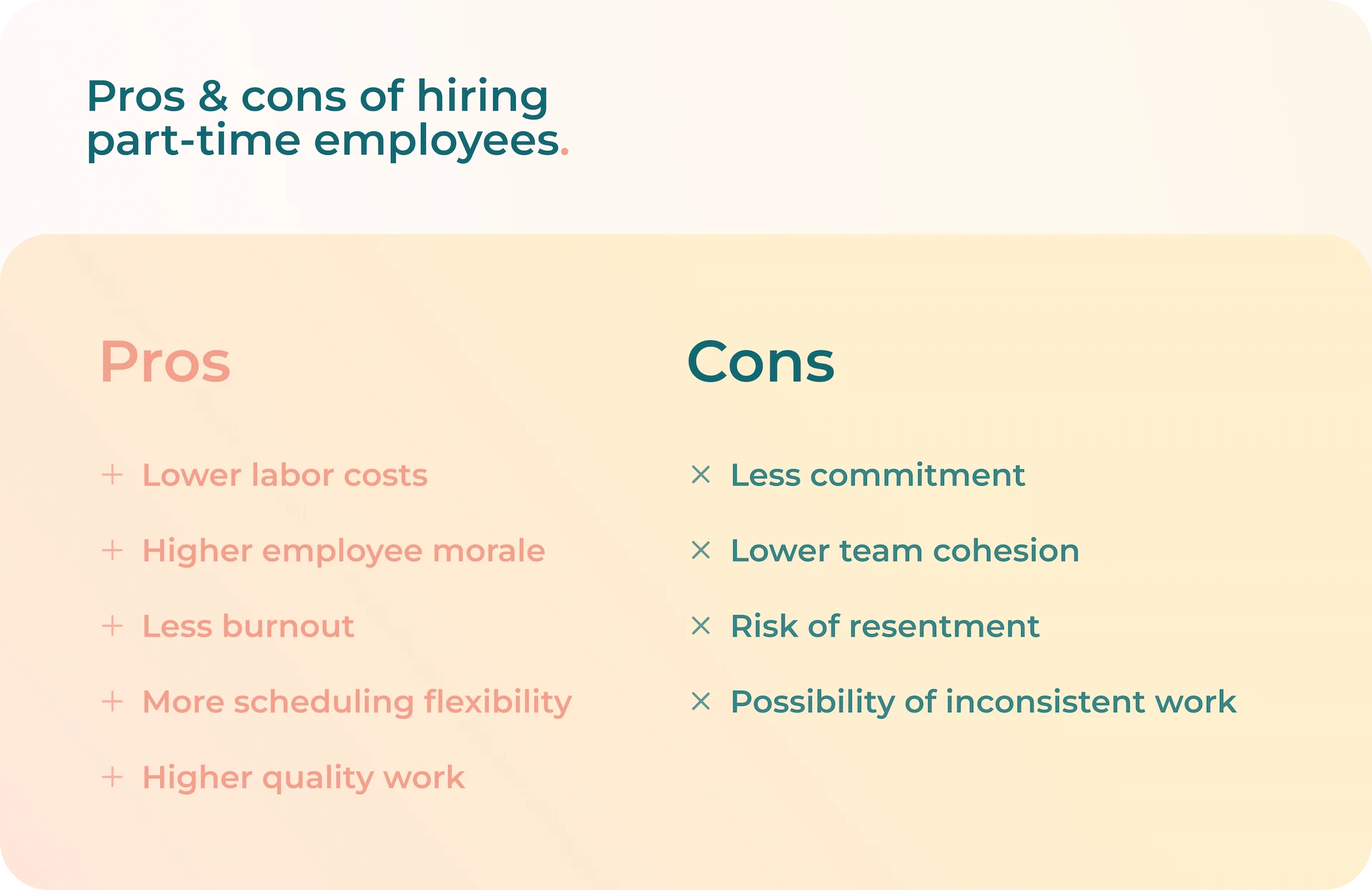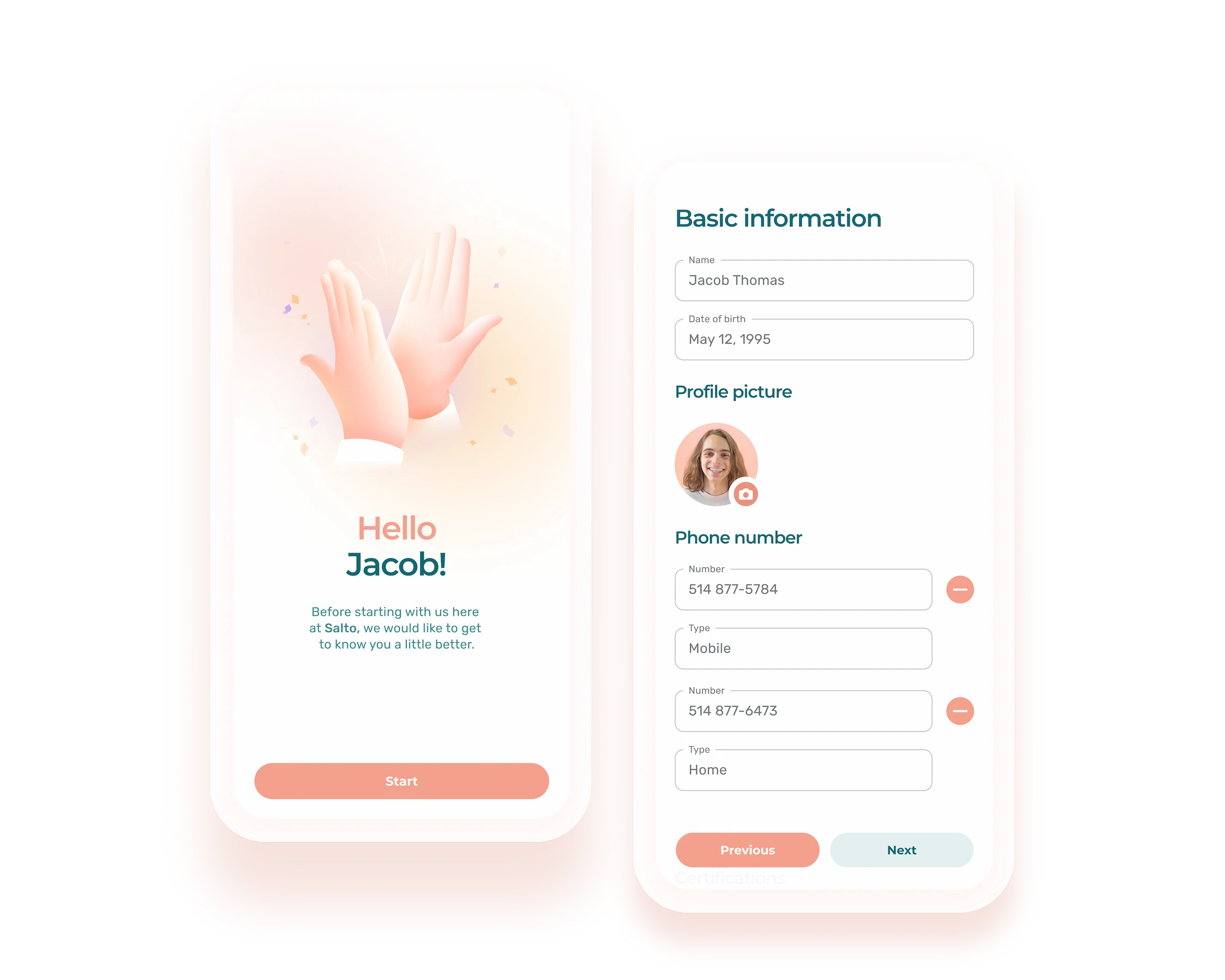How do seasonal vs. part-time jobs differ? What are the pros and cons of each employment status?
This article will help you determine whether hiring part time vs. seasonal employees makes more sense for your business.
What Is Seasonal Employment?
Seasonal employment refers to temporary jobs offered by businesses to meet short-term surges in workload. Seasonal jobs are common in industries like retail, tourism, agriculture, and construction, and typically coincide with peak periods like holiday seasons, summer, or harvest times.
A seasonal employee may be someone who is looking for temporary work, extra income, or industry-specific experience, and may work on a part-time, full-time or recurring basis.
What Is Part-Time Employment?
Part-time employment refers to a work arrangement in which employees work less than the standard full-time working hours, typically under 35 hours per week. Due to their fewer working hours, part-time jobs offer more flexibility and generally a better work-life balance. Part-time jobs can be temporary or permanent positions and can be found across all industries and job types.
Seasonal vs. Part-Time Staffing
Seasonal and part-time staff are not the same, although they do share certain similarities.

Similarities
Flexible Schedules
Both part-time and seasonal employees often have flexible work schedules. Seasonal and temporary employment is therefore a good choice for students, individuals with other commitments, or those seeking a good work-life balance.
Temporary Nature
Both part-time and seasonal jobs can be temporary in nature. Seasonal jobs are inherently temporary because they are tied to specific seasons, while part-time jobs can be either a temporary or permanent position.
Variety of Industries
Both part time and seasonal jobs can be found across a range of industries, from retail and hospitality to agriculture and tourism.
Supplemental Income
Both part time and seasonal jobs can provide supplemental income to individuals who may be pursuing other goals, such as education or another career.
Lower Hours
Compared to full-time employment, both part time and seasonal employees typically work fewer hours per week. Most part-time workers clock less than 35 hours per week; seasonal workers may work part-time, full-time, or even overtime hours, but only for the season of employment.
Agendrix is an all-in-one HR toolkit for hiring and scheduling seasonal and part time workers for small businesses.
Differences
Duration
A part time job can be either long-term or permanent positions. Seasonal jobs, on the other hand, are inherently temporary, tied to specific times of the year.
Consistency
A part time job generally provides a consistent schedule over a longer period, whereas seasonal work tends to be intense and demanding during peak periods and then ends.
Benefits
A part-time employee may receive prorated benefits like health insurance or paid time off, depending on the employer and local labor laws. Seasonal workers, however, may not have access to the same benefits due to the short-term nature of their employment.
It’s important for businesses to consult the fair labor standards act to know their obligations when offering work on a seasonal basis as well as any mandatory part-time employee benefits they must offer.
Predictability
A part time job is generally more predictable as it isn’t typically subject to seasonal fluctuations. In contrast, some seasonal work can vary greatly from one season or year to the next.
Availability
The availability of part time work is generally consistent throughout the year, while seasonal job openings concentrate around specific times of the year related to holidays, tourism season, or agricultural cycles.
Benefits and Drawbacks of Hiring Seasonal vs. Part-Time Employees
Benefits of Hiring Seasonal Employees

More Flexible Staffing
Hiring seasonal employees can be a great solution for businesses with fluctuating staffing requirements. Businesses get the flexibility to bring on more workers as needed without having to commit more money to full-time salaries when staffing needs surge, or make difficult layoffs when needs wane again a few months later.
Lower Labor Costs
Hiring seasonal workers can lower overhead and training costs for the business. Employers are not required to offer seasonal workers the same benefits as they do to a full-time employee, such as health insurance, paid time off, and retirement plans. Training costs for seasonal workers may also be lower than for a full-time employee, particularly if the same seasonal workers return each season.
Less Overtime Costs
Overtime generally occurs when demand surpasses existing workforce capacity, leading to unnecessary costs. Businesses that have a predictable busy season can control payroll costs by hiring seasonal workers. This strategy allows businesses to meet demand while maintaining employee satisfaction.
Better Employee Morale
When demand surges but you don’t add on extra helpers, your permanent staff might have to work twice as hard. Both employee morale and productivity suffer when staff is overworked and stressed. It can also lead to a higher turnover rate. Seasonal workers can be used to support your existing team and take some of the pressure off their shoulders.
Drawbacks of Hiring Seasonal Workers
Lack of Commitment
Seasonal workers are employed with the business for only a few weeks or months and may not be as engaged, reliable, or motivated to do their best work, unlike staff in a permanent position.
Businesses must be clear about their expectations when hiring seasonal employees. Strive to offer a good employee experience and rehire reliable employees from previous seasons. Businesses that offer many seasonal jobs should keep good employee records to facilitate future hiring.
Lack of Training
Most seasonal employees receive only minimal training. As a result, they may be unprepared or unable to keep up with the workload. A lack of proper training is associated with higher turnover rates. Businesses must implement a clear staff training plan to improve employee retention.
Lack of Loyalty
Seasonal workers who come and go won’t necessarily have the same sense of loyalty as those in a permanent position. Businesses should strive to build a crew of loyal, repeat seasonal workers by offering competitive pay, flexible hours, and a positive employee experience.
Benefits of Hiring Part-Time Employees
Lower Labor Costs
Hiring part-time employees can be extremely cost effective for a business. A part-time employee is typically paid an hourly wage. Nor do they always receive benefits. What’s more, work hours can be scheduled around the needs of the business.
If you need more staff on weekends and the holidays, and fewer staff during the summer months, then it may make more sense to hire part-time employees. Businesses need to be informed of the minimum wage they are required to pay each part-time employee on their staff.
Higher Employee Morale
Part-time workers can ease the workload of full-time employees and give them more freedom to request time off for vacations and personal days. It also leaves them more time and energy for professional development, which can directly boost business performance. Businesses can use part-time employees to fill scheduling gaps and to reduce overtime hours of full-time employees.
More Scheduling Flexibility
Part-time workers do not necessarily have to work a fixed number of hours each week, unlike full-time employees. Many businesses schedule part-time employees as needed to ensure acceptable productivity levels without paying unnecessary wages.
Businesses can use a part time job to ensure coverage during night or weekend shifts. Employee scheduling software will make it easier to track employee time & attendance at various job sites, and give employees different ways to clock.
Less Burnout
Employee burnout is on the rise, but much less so with those working a part time job. Working fewer hours leaves room for a better work life balance, which means part-time employees with a regular job are often refreshed and enthusiastic about their work.
Higher Quality Work
Part-time employees can be trained to perform specific tasks, enabling them to produce better quality work than full-time employees who often have to juggle a variety of tasks. This practice is often seen in part-time administrative or manufacturing positions.
Drawbacks of Hiring Part-Time Staff
Less Committed
Depending on their employee experience and the number of hours worked each week, part time staff may not be as committed to your business as full time staff. part-time employees have less opportunity to learn about their roles, teams, and company, along with its culture. This can result in poor employee loyalty.
Businesses can consider offering a part time job with proportional benefits. They can also take steps to ensure they feel valued, such as by conducting regular surveys and sending high fives to staff that go above and beyond.
Less Team Cohesion
Part-time workers spend less time in the workplace compared to full-time employees. This can make team cohesion and collaboration a challenge, particularly if part-time employees do not receive adequate training or onboarding.
Businesses should have solid onboarding tools in place.
Risk of Resentment
Since part time workers tend to work fewer hours, this can inadvertently lead to friction due to perceived differences in workload. full-time employees might feel they are shouldering a heavier workload and providing greater value to the company.
Businesses need to be clear about the expectations but also the rights of all types of workers, regardless of employment status, and communicate this information to their team. This will help to avoid potential misunderstandings or resentment.
Risk of Inconsistent Work
Part-time employees rarely work full days and may not have enough hours during each shift to start and finish certain tasks. Their shorter working hours and potentially limited understanding of the company’s procedures and objectives could impact the quality and productivity of their work.
Temporary vs. Seasonal Employees
Contrary to what many small business owners believe, seasonal and temporary employment is not the same thing.
Temporary workers, often known as ‘temps’, are usually employed to substitute for absent employees or bridge gaps in a company’s workforce. This might occur during the business’s busy times or in response to employees taking leave, such as maternity leave. They may only be with the company for a few weeks.
A temporary worker can be recruited directly by the business or hired through a temporary staffing agency; in the latter case, temporary workers are effectively leased, and the employer pays placement fees to the agency. Several industries, including healthcare and IT, commonly utilize temporary staff.
Temporary workers could be full-time or part-time, depending on the company’s needs. While they may not always be eligible for benefits, some agencies may offer healthcare and other benefits. If a temporary worker proves to be a valuable asset, businesses will often consider them for permanent positions.
Hiring Temporary Employees: Benefits and Drawbacks

Benefits
- Hiring a temporary worker allows the business to fill temporary workforce gaps
- Replacing temporary employees that underperform is easy if the temp is hired through a staffing agency
- Hiring temporary workers allows the business to fill permanent positions with candidates that have on-the-job training, if the temp is a good fit
Drawbacks
- Businesses need to pay fees if they hire temporary workers through a temporary staffing agency
- A temporary worker generally receives few or no benefits
Conclusion
The right mix for your business may be a blend of permanent full-time and part-time employees, augmented by seasonal and temporary workers as the need arises.
Juggling these different temporary and permanent positions simultaneously may complicate employee scheduling a little, but it will allow you to meet fluctuating demand in the most cost effective manner.
Whatever your employment status mix, make sure you have an adequate scheduling strategy in place and use employee scheduling software to avoid potential scheduling problems.
What Is the Difference Between Seasonal and Full-Time?
Seasonal employment is a temporary work arrangement aligned with specific peak periods, like holidays, summer, or harvest seasons. Employment lasts only a few weeks or months and terminates with the end of the set period. Businesses that hire seasonal employees often give them the option to return each year.
Full-time employment is a steady work arrangement where an individual works a set minimum number of hours weekly, typically between 35 to 40. These permanent positions offer more stability than seasonal positions. full-time employees often enjoy access to extra benefits such as health coverage, paid leave, and retirement plans, benefits that may not extend to seasonal workers.
Why Do Companies Hire Part-Time Instead of Full-Time?
There are many reasons why a business may opt to hire part-time workers over full-time personnel.
- More scheduling flexibility: Part-time employees can be scheduled to support full-time staff during a busy time period, seasonal surge, or specific shift that may not necessitate a full time workforce.
- Lower payroll costs: Hiring part-time workers can result in substantial cost saving for a business. Businesses are not required to offer part time staff benefits such as health coverage, paid leave, or retirement plans.
- Less risky hiring: Hiring part-time workers allows businesses to evaluate the employee’s suitability and performance prior to committing more money to a full-time position.
- Better use of resources: Some roles within the business may only require part time hours due to a workload insufficient to warrant a full-time employee.
- Easier compliance with laws: Some countries and laws require businesses to extend certain benefits to full-time employees. Part-time positions do not necessarily have to meet the same requirements.
- More diversity: Part-time positions may appeal to individuals unable to take on a full-time schedule, like people with disabilities, students, or retirees. This is one way for businesses to meet their diversity targets. Hiring young employees also brings an influx of energetic new ideas and approaches.
- Access to a bigger talent pool: Not all workers want to work full time hours. Businesses that offer a variety of employment types, including part time work, can potentially access a larger talent pool and thereby improve overall performance.











